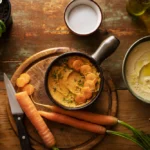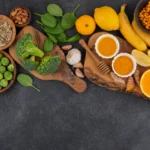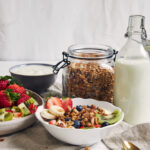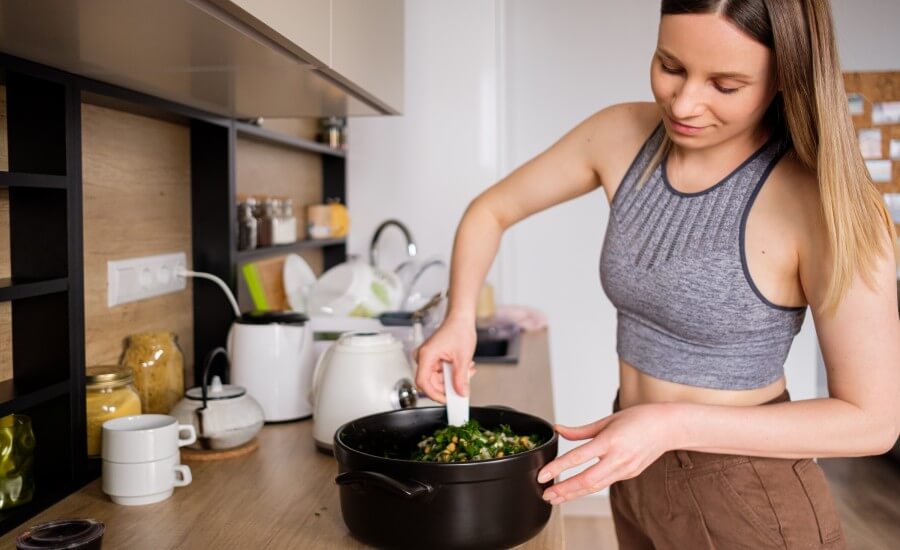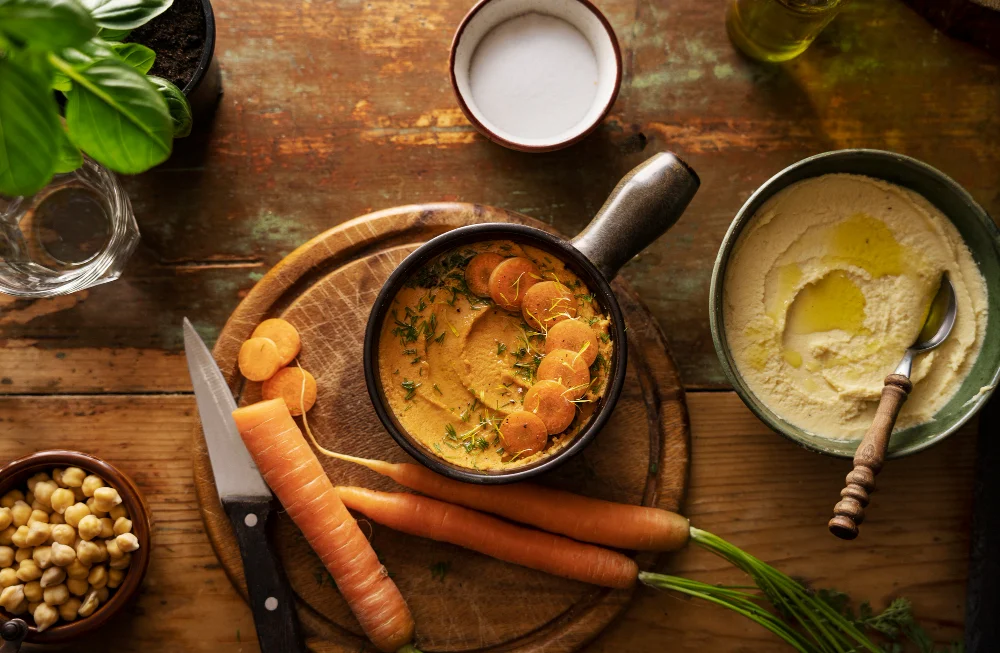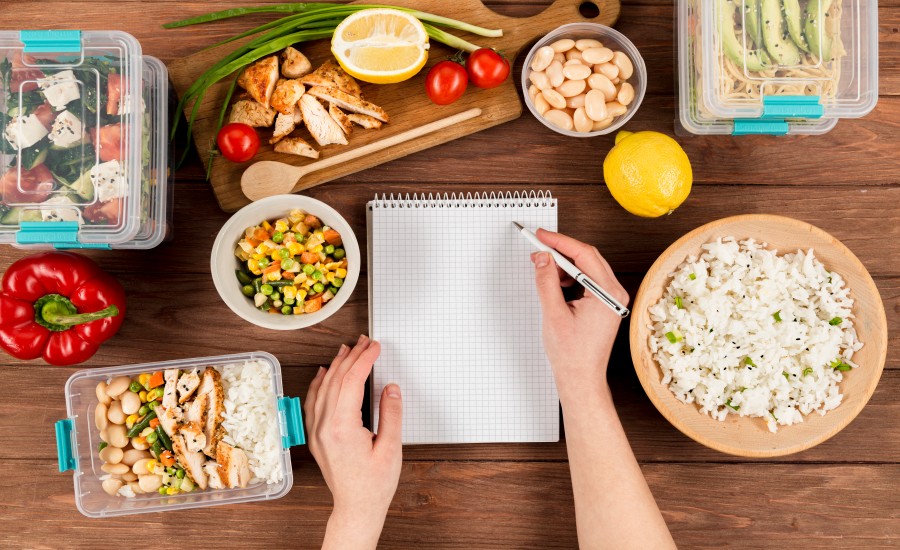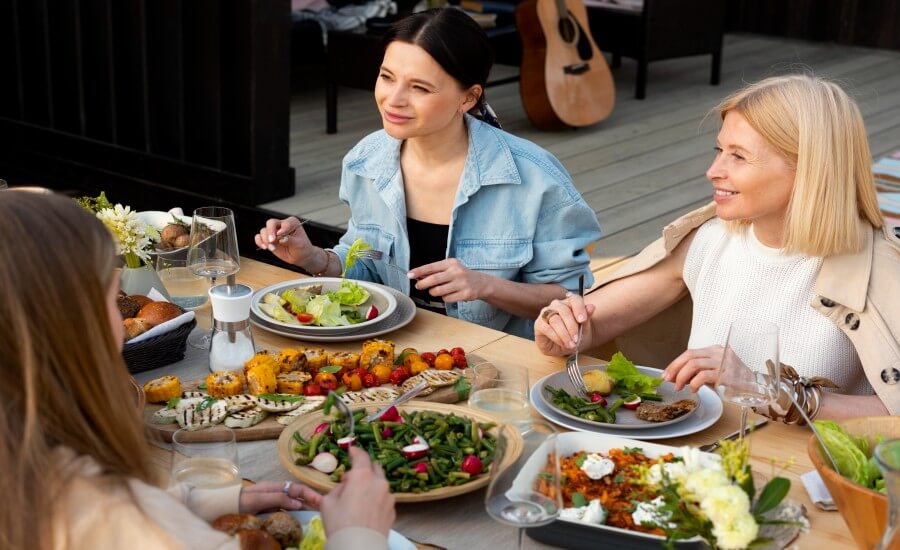In our quest for delicious, home-cooked meals that fit into packed schedules, modern kitchen technology offers powerful solutions. Electric pressure cookers, popularly known by the brand name Instant Pot, have revolutionized fast cooking, significantly reducing time spent over the stove. These multi-cookers are particularly brilliant for vegan cuisine, effortlessly handling staples like legumes and grains. While traditional stovetop pressure cookers are a fixture in most Indian kitchens, electric versions offer added convenience and programmability. This guide explores the world of quick vegan Instant Pot recipes, examining the nutritional implications of pressure cooking, the ethical dimensions of speed and accessibility, the environmental footprint, and practical tips to help you master this appliance for flavorful plant-based meals, right here in Jaipur and beyond.
Effortless & Healthy: Vegan Meals Made Fast in the Instant Pot
LENS 1: Nutritional Analysis (Fast Food, Healthy Profile?)

Does faster cooking under pressure impact the nutritional quality of vegan meals? Let’s break it down.
- Nutrient Retention: Pressure cooking’s main advantage is speed. By cooking food much faster at higher temperatures (around 120°C/250°F due to increased pressure), the duration of heat exposure is significantly reduced. This can lead to better retention of certain heat-sensitive vitamins (like Vitamin C and some B vitamins) compared to long boiling or even slow cooking, where degradation over time is greater. However, the high temperature itself can affect some delicate phytonutrients. Minerals are generally stable. Nutrients leaching into the cooking liquid are largely retained as the liquid is usually consumed in dishes like dals and curries.
- Legume Powerhouse: Electric pressure cookers excel at cooking dried beans and lentils quickly, often without prior soaking (though soaking still aids digestibility for some beans like rajma). This makes incorporating these incredibly nutritious, affordable vegan staples (dal, chana, rajma) far more convenient for weeknight meals compared to long stovetop simmering. Pressure cooking may also help break down some anti-nutrients like phytates, potentially improving mineral absorption.
- Balanced One-Pot Meals: Instant Pots make it easy to create balanced vegan meals in one pot – think Vegetable Pulao with chickpeas, Khichdi with lentils and vegetables, or even pasta dishes where everything cooks together.
- Vegetable Considerations: The speed can be a double-edged sword for vegetables. They cook very quickly under pressure. To avoid mushiness and maximize nutrient retention:
- Add vegetables later in the cooking cycle if possible (e.g., add greens after pressure cooking is complete, using residual heat).
- Use the “Quick Release” (QR) method for vegetables instead of “Natural Pressure Release” (NPR) to stop cooking faster.
- Cut vegetables into larger chunks.
- Sodium & Fat Control: Cooking from scratch allows complete control over salt and oil, generally resulting in healthier meals than processed foods or takeout. The moist cooking environment often requires less added fat. Remember your B12 supplement! How can you adjust cooking times or release methods in your Instant Pot to keep vegetables crisp-tender?
Nutritional Deep Dive: Nutrient Retention Under Pressure
Compared to other methods:
- vs. Boiling: Pressure cooking uses less water and significantly shorter times, generally resulting in better retention of water-soluble vitamins (C, B vitamins) that would leach out and degrade during prolonged boiling.
- vs. Slow Cooking: Pressure cooking’s speed minimizes time-related degradation of heat-sensitive vitamins, potentially offering an advantage. Slow cooking might be gentler temperature-wise but the duration is much longer.
- vs. Roasting/Frying: Pressure cooking uses lower temperatures (around 120°C) than typical roasting/frying (>175°C), potentially preserving some heat-sensitive compounds better, though it doesn’t create the same Maillard reaction textures.
- Key: Minimal water, fast cooking time, and consuming the cooking liquid contribute to good nutrient retention in pressure-cooked vegan dishes like dals and bean curries.
Voice of Experience (Nutrition Scientist): “Electric pressure cooking offers significant benefits for vegan diets by making nutrient-dense dried legumes highly convenient. The rapid cooking can preserve certain vitamins better than long boiling. The key is mastering the timing, especially for vegetables, to retain both nutrients and desirable texture, and ensuring you consume the nutrient-rich cooking liquid.” – Dr. Anisha Singh, Food Science & Nutrition
LENS 2: Ethical Framework (Conscious Speed & Accessibility)
The speed and convenience offered by appliances like the Instant Pot have noteworthy ethical dimensions.
- Accessibility of Home Cooking: By drastically cutting cooking times for staples like dal and rajma (compared to non-pressurized stovetop), electric multi-cookers make preparing healthy, homemade, compassionate vegan meals significantly more achievable for people with demanding schedules, limited time due to work or caregiving, or those less experienced in the kitchen. This promotes food equity.
- Reducing Reliance on Less Ethical Options: When home cooking is easier and faster, reliance on potentially less healthy, less sustainable, or less ethically produced ultra-processed convenience foods and frequent takeout may decrease.
- Food Waste Reduction: The speed allows for quickly cooking vegetables that are slightly past their prime into soups or curries before they spoil completely. Batch cooking large quantities of beans or grains from dried is easy, facilitating planned leftovers and reducing waste.
- Technology & Liberation: Kitchen technology can be seen as liberating, particularly historically for women, by reducing domestic labour time. However, it’s also worth considering if reliance on automated appliances disconnects us from traditional cooking skills or creates new consumer pressures.
- Affordability of Staples: By making the cooking of dried beans and lentils (extremely affordable protein in India) fast and easy, these appliances support economically accessible veganism. How does the time saved by using an Instant Pot potentially enable you to allocate resources (time, energy) towards other valued activities or ethical pursuits?
Hidden Benefits: Reduced Kitchen Stress & Increased Whole Food Intake
The ability to quickly cook foundational staples like beans and grains from scratch can lead to increased consumption of these healthy whole foods and significantly reduce the stress associated with getting a nutritious dinner on the table after a long day.
Voice of Experience (Busy Vegan Parent, India): “My Instant Pot changed my vegan journey! Coming home from work, I can cook rajma from soaked beans in under 30 minutes, or make a quick vegetable pulao. It means we eat healthy, homemade vegan food almost every night, which felt impossible before. It makes compassionate eating practical for my family.” – Sunita Kumar, Software Engineer
Critical Reassessment: The Access Hurdle
While beneficial for those who own one, electric multi-cookers represent a significant upfront cost compared to traditional stovetop pressure cookers (which are near-universal in India) or basic pots and pans. This cost can be a barrier to accessibility for lower-income households, highlighting that technology alone doesn’t solve food justice issues.
Read more: Best Vegan Instant Noodles Ideas: Quick & Tasty Guide
LENS 3: Ingredient Science & Environment (Efficient Pressure & Footprint)
Electric pressure cookers leverage physics for speed and efficiency, with notable environmental implications.
- The Science of Speed: By sealing the pot, steam builds up, increasing the internal pressure. This higher pressure raises the boiling point of water significantly above 100°C (to around 120°C / 250°F at typical ~15 psi). This superheated steam penetrates food rapidly, drastically accelerating cooking processes like tenderizing legumes and breaking down starches.
- Energy Efficiency: Compared to other methods for similar tasks:
- vs. Stovetop Simmering (long): Electric pressure cookers use significantly less energy because the cooking time is dramatically shorter, even if their heating element uses moderate power.
- vs. Oven: Far more energy efficient than running a large oven for hours to bake beans or braise.
- vs. Slow Cooker: Uses higher wattage but for much less time. For short tasks, it’s comparable; for long tasks like cooking dried beans, the Instant Pot often uses less total energy (kWh) due to the massive time saving.
- vs. Stovetop Pressure Cooker: Electric models might use slightly more peak power for the heating element, but the insulated pot retains heat efficiently. Overall energy use is often comparable, with electric offering more programmability.
- Water Efficiency: The sealed environment prevents almost any water evaporation during cooking, requiring less initial water than stovetop methods and conserving water.
- Enabling Sustainable Staples: The biggest environmental win is how easily Instant Pots cook dried legumes (beans, lentils, chickpeas) from scratch. Dried legumes have minimal packaging and a very low carbon and water footprint compared to canned legumes (transporting water/heavy cans) and especially compared to animal protein. How does the ability to quickly cook dried beans in an Instant Pot encourage more sustainable eating habits compared to relying on canned beans or meat?
Market Transformation Map Suggestion: Data showing the sharp rise in global sales of electric multi-cookers (Instant Pot and competitors) over the past decade, potentially with specific data points or projections for the Indian market.
Voice of Experience (Energy & Appliance Expert): “Electric pressure cookers are remarkably energy efficient for tasks requiring long cooking times, like preparing dried beans or tough cuts (in non-vegan contexts). By slashing cooking duration through increased pressure and temperature, their overall energy consumption (kWh) is often lower than extended stovetop simmering or oven use, despite their heating elements drawing significant power when active.” – Dr. Ajay Mathur, Energy Efficiency Bureau (hypothetical link)
LENS 4: Everyday Practitioner’s Experience (Recipes, Tips & Techniques)
Mastering your electric pressure cooker for quick vegan Instant Pot recipes unlocks a world of fast, flavourful meals, especially adaptable for Indian cuisine.
Essential Instant Pot Techniques:
- Know Your Buttons: Understand core functions: ‘Pressure Cook’ (or ‘Manual’), ‘Sauté’, ‘Steam’. Pressure Level (High/Low) and Time settings are key.
- Sauté First: Crucial for most Indian dishes. Use the ‘Sauté’ function to heat oil, perform tadka (bloom spices like jeera, rai, hing), sauté onions, ginger, garlic until fragrant before adding other ingredients and pressure cooking. This builds essential flavour layers.
- Liquid is Necessary: You need sufficient liquid (usually at least 1 cup for standard 6-qt models, check manual) to build steam pressure. Too little can trigger burn warnings.
- Don’t Overfill: Never fill beyond the MAX PC line (usually 2/3 full, or 1/2 full for foods that expand like beans/grains).
- Sealing: Ensure the lid is locked correctly and the steam release valve is set to ‘Sealing’ position before pressure cooking starts.
- Pressure Release (NPR vs. QR):
- Natural Pressure Release (NPR): Let pressure release gradually after cooking time ends. Best for meats (less relevant for vegan), beans (helps them stay intact), broths (prevents sputtering). Takes 10-30 mins.
- Quick Release (QR): Carefully turn the valve to ‘Venting’ to release steam rapidly. Best for vegetables, pasta, or anything you want to prevent from overcooking. Use caution with hot steam!
- Layering: Sometimes helpful to place vegetables on top of liquids/beans to prevent scorching or overcooking.
- Pot-in-Pot (PIP): Cooking food in a separate container (like a steel bowl) placed on a trivet inside the main pot with water underneath. Good for steaming, cooking rice alongside curry, or making desserts.
Quick Vegan Instant Pot Recipe Ideas (Indian Focus):
(Times are approximate after pressure build-up; adjust based on your model)
- 10-Minute Dal Tadka (from dried Masoor Dal): Sauté tadka (jeera, rai, hing, chili, garlic) in IP. Add rinsed masoor dal (red lentils), water/broth (ratio ~1:3 dal:water), turmeric, salt. Pressure cook High for 5-7 mins + NPR 5-10 mins. Garnish with coriander.
- Quick Chana Masala: Sauté onion-ginger-garlic masala base + spices in IP. Add soaked (or unsoaked – cook longer) chickpeas, diced tomatoes, water/broth. Pressure cook High (soaked: ~15 mins + NPR; unsoaked: ~35-40 mins + NPR). Finish with garam masala, lemon, coriander.
- Fast Rajma Masala: Use soaked kidney beans. Sauté masala base. Add beans, water/broth, spices. Pressure cook High ~25-30 mins + NPR. Mash some beans to thicken gravy.
- Vegetable Pulao: Sauté whole spices (cardamom, clove, cinnamon) & onions in IP. Add ginger-garlic paste, mixed vegetables (carrots, peas, beans, potatoes), rinsed basmati rice, water/broth (ratio ~1:1 rice:liquid usually works, check model), salt, turmeric, garam masala. Pressure cook High ~4-5 mins + NPR 10 mins. Fluff with fork.
- Simple Khichdi: Rinse rice and moong dal well. Sauté tadka (jeera, hing) in IP. Add rice, dal, turmeric, salt, water (ratio ~1:4 grains:water for soft khichdi). Pressure cook High ~6-8 mins + NPR.
- Steamed Vegetables: Place chopped vegetables (broccoli, carrots, potatoes) in steamer basket on trivet with 1 cup water in bottom. Pressure cook High ~1-3 mins (depending on veg) + QR immediately.
What Indian dish that normally takes a long time would you be most excited to try making quickly in an Instant Pot?
Daily Impact: From Dried Beans to Dinner Faster
The single biggest impact for many Indian vegan cooks is the ability to cook dried beans and lentils quickly without hours of simmering or constant monitoring, making these affordable staples genuinely convenient for weeknights.
Voice of Experience (Instant Pot Enthusiast): “My Instant Pot is my kitchen superhero! I make perfect dal from dried lentils in 15 minutes total, cook chickpeas for chana masala without soaking overnight if needed, and make vegetable pulao that tastes like it simmered for ages. The Sauté function is key for getting those Indian flavours right before pressure cooking.” – @InstantPotIndiaVegan (hypothetical social handle)
Alternative Approaches: Stovetop Pressure Cookers & Specific Functions
- Traditional Pressure Cookers: Still highly effective and very common in India. Lack the presets and walk-away convenience of electric models but achieve similar speed using stovetop heat. Techniques are similar.
- Other IP Functions: Explore ‘Steam’, ‘Rice’, ‘Porridge’, or even ‘Yogurt’ functions (for making vegan yogurt if your model supports stable low temps) for further versatility.
PERSPECTIVE INTERSECTION MATRIX
- Nutrition & Speed (Lens 1 & 4): The IP’s speed (Lens 4) facilitates cooking nutrient-dense dried legumes (Lens 1) quickly and may offer nutrient retention benefits (Lens 1). Quick cooking requires careful timing for vegetables (Lens 4) to optimize nutrition (Lens 1).
- Ethics & Accessibility (Lens 2 & 4): The convenience offered by IP recipes (Lens 4) makes ethical home cooking (vegan, low-waste) more accessible for time-poor individuals (Lens 2).
- Environment & Efficiency (Lens 3 & 4): The energy efficiency for certain tasks (Lens 3) is realized through practical use (Lens 4), especially when cooking low-footprint staples like dried beans (Lens 3, 4).
- Science & Technique (Lens 3 & 4): Understanding pressure cooking science (higher temps, faster cooking) (Lens 3) informs practical techniques like using QR for vegetables or adjusting liquid ratios (Lens 4).
- Indian Context & Technology (All Lenses): Adapting IP cooking (Lens 4) for Indian cuisine leverages existing pressure cooking knowledge while offering new conveniences, impacting nutrition (Lens 1), ethics (Lens 2 – accessibility), and potentially environment (Lens 3 – energy use).
MISCONCEPTION ANALYSIS
| Misconception | Reality |
| Electric Pressure Cookers (Instant Pots) are dangerous or prone to exploding. | Modern electric multi-cookers have multiple built-in safety features (lid lock, pressure sensors, temperature control) making them significantly safer than older stovetop models when used correctly according to instructions. |
| Pressure cooking destroys all the nutrients in food due to high heat/pressure. | The quick cooking time can actually preserve certain heat-sensitive and water-soluble vitamins better than longer cooking methods like boiling or slow cooking. Overall nutrient retention is generally good, especially as liquids are consumed. |
| Food cooked in an Instant Pot always ends up mushy and tastes one-dimensional. | Mushiness results from incorrect timing or using NPR when QR is needed (esp. for veg). Using the ‘Sauté’ function first to build flavour layers and adding ingredients in stages prevents bland, uniform results. Technique matters! |
| Instant Pots are only useful for cooking meat or large batches of beans. | They are incredibly versatile for vegan cooking: perfect rice/grains, quick dals, one-pot pastas, steamed vegetables, soups, stews, pulao/biryani, oatmeal/porridge, khichdi, and even some desserts or vegan yogurt. |
| They are complicated to use with too many buttons. | While they have multiple functions, the core ‘Pressure Cook’ (or ‘Manual’) and ‘Sauté’ functions are straightforward and cover most needs. Many recipes only require setting time and pressure level. |
KEY TURNING POINTS
- Invention of Stovetop Pressure Cooker (17th C, practical models later): Introduced the concept of faster cooking under pressure.
- Widespread Adoption in India: Stovetop pressure cookers became near-universal kitchen appliances in India for quickly cooking dals, rice, and vegetables.
- Launch of Instant Pot (2010): Revolutionized the market with user-friendly electric multi-cookers offering presets, safety features, and functions beyond pressure cooking (sauté, slow cook, etc.).
- Online Community Boom: Massive online communities (Facebook groups, blogs, YouTube) dedicated to Instant Pot cooking rapidly shared recipes, tips, and troubleshooting, accelerating adoption.
- Adaptation of Global Cuisines: Users and recipe developers quickly adapted recipes from all cuisines, including diverse Indian dishes, for the Instant Pot format.
SYNTHESIS & RECOMMENDATIONS
Quick vegan Instant Pot recipes offer a game-changing combination of speed, convenience, and flavour for plant-based kitchens. These electric multi-cookers excel at rapidly transforming affordable staples like dried lentils and beans into delicious meals, making healthy, homemade vegan eating incredibly accessible, even on the busiest weeknights. While building flavour often requires using the ‘Sauté’ function first (especially for Indian dishes) and careful timing is needed for vegetables, the overall energy efficiency and time savings are substantial. Whether supplementing or replacing traditional Indian pressure cookers, the Instant Pot is a powerful tool for creating nourishing, compassionate, and delicious vegan food with ease.
Recommendations for Quick Vegan Instant Pot Success:
- Utilize ‘Sauté’ First: For maximum flavour in Indian dishes, always use the Sauté function to heat oil, bloom spices (tadka), and cook onions, ginger, and garlic before pressure cooking.
- Master Liquid Ratios: Use less liquid than stovetop recipes, typically just enough to cover ingredients and meet the minimum requirement for pressure building (check your manual).
- Learn NPR vs. QR: Use Natural Pressure Release (NPR) for beans, lentils, and broths to maintain texture and prevent sputtering. Use Quick Release (QR) immediately for vegetables or pasta to prevent overcooking.
- Cook Beans from Dried: Embrace the ability to cook most dried beans quickly (often under 40 minutes) – it’s cheaper, healthier (no added salt), and more sustainable than canned. Soak rajma/chana for better texture if time permits.
- Layer Smartly: Place ingredients that need longer cooking (beans, root veg) at the bottom, and quicker-cooking items or those prone to scorching (tomatoes) on top.
- Add Delicate Ingredients Last: Stir in leafy greens, coconut milk/cream, fresh herbs, or lemon juice after pressure cooking is complete, using the ‘Sauté’ function briefly or residual heat.
- Follow Tested Recipes (Initially): Start with recipes specifically designed for your appliance model until you understand timings and liquid requirements.
- Don’t Forget Safety: Read your manual, ensure the valve is sealed correctly, don’t overfill, and use caution when releasing pressure.
FURTHER AREAS OF EXPLORATION
- The Ultimate Guide to Cooking Dried Beans in an Instant Pot (Soaked vs. Unsoaked)
- Best Vegan Dal Recipes Specifically for the Instant Pot
- One-Pot Vegan Pasta Recipes in the Instant Pot
- Converting Your Favourite Stovetop Indian Curries to the Instant Pot
- Instant Pot vs. Traditional Indian Pressure Cooker: A Detailed Comparison
- Vegan Pot-in-Pot (PIP) Cooking Techniques & Recipes
- Using the Instant Pot for Vegan Staples (Yogurt, Broth, Grains)

